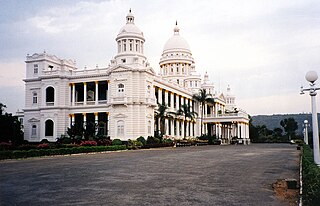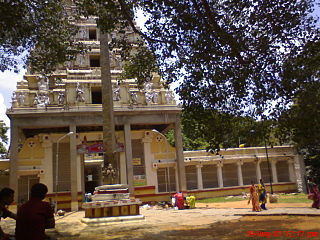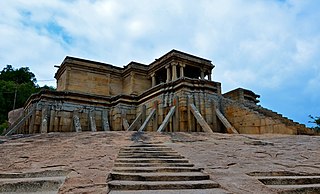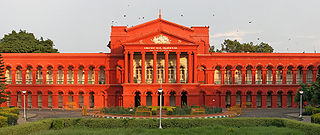The List of religious buildings and structures of the Kingdom of Mysore includes notable and historically important Hindu temples, royal palaces, churches, mosques, military fortification and other courtly structures that were built or received significant embellishment by the rulers of the Kingdom of Mysore. The term "Kingdom of Mysore" broadly covers the various stages the Mysore establishment went through: A Vijayanagara vassal (c. 1399 – 1565), an independent Hindu Kingdom ruled by the Wodeyar dynasty (c. 1565 – 1761), ruled by the de facto rulers Hyder Ali and Tipu Sultan who took control of the Kingdom (c. 1761 – 1799), and a princely monarchy under the British Raj (c. 1799 – 1950) before the establishment became a part of an independent India. [1] [2]
| Name of the structure | Photo | Timeline | Location | Notes |
|---|---|---|---|---|
| Kodi Bhairavaswamy (or Kodi Someshwara Swamy) |  | c. 1399 | Mysore palace grounds | Built by the brothers Yaduraya and Krishnaraya (r. 1399–1423), the founders of the dynasty [3] |
| Lakshmiramana Swamy |  | c. 1499 | Mysore palace grounds | From the Banni mantapa inscription it is known the temple was consecrated in 1499 during the rule of Chamaraja Wodeyar II (r. 1478–1513) with later additions by Kings Narasaraja Wodeyar I (r. 1638–1659) and Krishnaraja Wodeyar III in 1851 [3] [4] |
| Gunja Narasimhaswamy |  | 16th century | Tirumakudal Narasipur | The pre-existing temple was under the patronage of the local governor of Mysore, during the Vijayanagara rule over South India. [5] |
| Trinayaneshvara Swamy |  | Earlier than c. 1578 | Mysore palace grounds | Existed before Raja Wodeyar I of (r. 1578–1617) and was later expanded by Kanthirava Narasaraja I (r. 1638–59). [3] |
| Lakshmikanta | c. 1625 | Heggaddevanakote | The original 13th-century Hoysala era construction was expanded by King Chamaraja Wodeyar VI (r. 1617–37). Additions included a pillared mahamandapa ("large hall") and a mukhamandapa ("entrance hall"). An inscription on the dhvajastambha ("flag pillar") in the temple claims King Chamaraja Wodeyar VI had it erected in c. 1625. [6] | |
| Narasimha Swamy | First half of 17th century | Srirangapatna | The temple was built by Kanthirava Narasaraja Wodeyar (r. 1638–1659). His statue (dated 17th century) and that of the main deity Narasimha were re-installed in c. 1826 by King Krishnaraja Wodeyar III. An inscription on the pedestal in the Kannada script confirms it is the statue of "Kanthirava Narasaraja Wodeyaravaru". [7] | |
| Nandi monolith |  | c. 1659 – 1673 | Chamundi Hills, Mysore | commissioned by King Dodda Devaraja (also called Dodda Kempadevaraja, r. 1659–1673). [3] |
| Shveta Varaswamy |  | Late 17th century-early 19th century | Mysore palace grounds | Built by King Chikkadevaraja Wodeyar (r. 1673–1704) and later expanded by Dewan Puraniah, chief minister of King Krishnaraja Wodeyar III ( (r. 1799–1868). [3] |
| Temple tank (Kalyani) |  | c. 1673 – 1704 | Shravanabelagola | King Chikkadevaraja Wodeyar constructed the pond and made a large endowments to the Jain monastic order at Shravanabelagola. [8] |
| Yoga Narasimha |  | c.1696 | Devarayana Durga hill | Built by King Chikkadevaraja Wodeyar [9] |
| Bhoga Narasimha |  | c.1696 | Devarayana Durga hill | Built by King Chikkadevaraja Wodeyar [9] |
| Paravasudeva |  | c. 1673 – 1704 | Gundlupet | The temple was built in Dravidian style during the rule of King Chikkadevaraja Wodeyar in memory of his father Doddadevaraja Wodeyar. [10] [11] |
| Gopala Krishna | c. 1673 – 1704 | Haradanahalli | Built by Chikkadevaraja Wodeyar in response to the taunts of the Maratha prince of Tanjore. [11] | |
| Varadaraja | c. 1673 – 1704 | Varkod | Built by Chikkadevaraja Wodeyar in response to the taunts of the Maratha prince of Tanjore. [11] | |
| Mahalakshmi |  | c. 1673 – 1704 | Mysore palace grounds | Built by King Chikkadevaraja Wodeyar about the same time as the Shveta Varahaswamy temple. [4] |
| Kote Venkataramana |  | c. 1689 | Bangalore | The temple was built in 1689 AD in Dravidian and Vijayanagara style by King Chikkadevaraja Wodeyar. [12] [13] |
| Lakshmikanta |  | Before c. 1732 | Kalale | The pre-existing temple was expanded and lavish grants were made by King Dodda Krishnaraja I (r. 1714–1732) before c. 1732. [14] |
| Kille Venkatramana Swamy |  | c. 1734 – 1766 | Mysore palace grounds | Built by King Krishnaraja Wodeyar II. [15] |
| Shivappa Nayaka Palace |  | c. 1760 – c. 1782 | Shivamogga | Though named after the Shivappa Nayaka, according to art historian George Michell, the palatial bungalow was actually built by the Mysore ruler Hyder Ali. [16] |
| Lal Bagh Botanical Garden |  | c. 1760 | Bangalore | First planned and laid out during the rule of Hyder Ali and later adorned with unique plant species by Tipu Sultan is a popular botanical garden.[ citation needed ] |
| Bangalore Fort |  | c. 1761 | Bangalore | First built in mud in c. 1537 by Kempe Gowda I, the founder of Bangalore, and later re-built in stone by Hyder Ali in 1761 and further improved by Tipu Sultan in the late 18th century. It was damaged during an Anglo-Mysore war in 1791. It still remains a good example of 18th-century military fortification. [17] |
| Madhugiri Fort |  | late 18th century | Madhugiri, Tumkur district | The original fort is ascribed to Here Gauda, a Vijayanagara vassal of the fifteenth century. In c. 1678 the fort was captured by Chikka Devaraja Wodeyar, the King of Mysore. Haider Ali extended and further strengthened it. [18] |
| Devanahalli Fort |  | c. 1760 – 1782 | Devanahalli | Chieftain Malla Byre Gowda of Avathi, a Vijayanagara empire vassal, built a mud fort in c. 1501 at Devanadoddi (now called Devanahalli). In the late 18th century, Hyder Ali re-constructed the fort in stone resulting in the current structure. [19] [20] |
| Colonel Bailey's Dungeon |  | before c. 1780 | Srirangapatna | Where Colonel Bailey was imprisoned by Hyder Ali and died in 1780. [21] |
| Narasimha Swamy |  | Late 18th century (before c. 1799) | Seebi | Built during the rule of Tipu Sultan by three wealthy brothers: Lakshminarasappa, Puttanna and Nallappa, who were the sons of Kacheri Krishnappa, a Dewan in the court of King Tipu Sultan. [22] [23] |
| Daria Daulat Bagh |  | c. 1784 | Srirangapatna | Tipu Sultan built this wooden this colonnaded palace (lit, "garden of the wealth of the sea"). Built in the Indo-Saracenic style, the palace is known for its intricate woodwork, striped columns, floral designs, and paintings. [24] |
| Gumbaz, Seringapatam |  | c. 1784 | Srirangapatna | Built by Tipu Sultan himself, holds the graves of Tipu Sultan and his father Hyder Ali. [25] |
| Tipu Sultan's Summer Palace |  | c. 1791 | Bangalore | The construction of the palace was commissioned by Hyder Ali in c. 1781 and completed by Tipu Sultan in c. 1791. [26] |
| Jama Masjid |  | c. 1794 | Srirangapatna | The Jama Masjid mosque named Masjid-e-Ala with two beautiful minarets was built by Tipu Sultan in 1794. [27] |
| Tipu Sultan's Palace |  | Late 18th century | Nandi Hills | Interior of Tipu Sultan's summer Palace. [28] |
| Nandi Hills Fort |  | Late 18th century | Nandi Hills | Fort built by Tipu Sultan on Nandi Hills. [29] |
| Manjarabad Fort |  | c. 1792 | Manjrabad, Hassan district | Built by Tipu Sultan who renamed 'Balam' as Manjarabad to reflect the foggy atmosphere in the fort ("fog" in native Kannada is manju) in the region. [30] |
| Srirangapatna Fort |  | Late 18th century | Srirangapatna | Currently nominated for recognition as UNESCO World Heritage Site. Epigraphically the fort dates back to c. 1220 rule of Hoysala Empire King Vishnuvardhana. Later the fort underwent modifications under the Vijayanagara empire and Kanthirava Narasaraja Wodeyar of the Mysore Kingdom in c. 1654. In c. 1791, the fort obtained its current design and structure under the rule of Tipu Sultan. A military authority who visited Srirangapatna in c. 1888 opined that it was the second strongest fort in India. [31] |
| War Memorial |  | After c. 1799 | Srirangapatna | Memorial for the British soldiers who died in the fourth Anglo Mysore war. [32] |
| Sultan Battery |  | Late 18th century | Mangalore | A coastal fort built by Tipu Sultan just outside Mangalore city. Currently only parts of the fortification remain. [33] |
| Tipu's Memorial |  | After c. 1799 | Srirangapatna | Spot where Tipu Sultan's died after Mysore's defeat to the British in fourth Anglo-Mysore war. [32] |
| Srikanteshwara |  | c. 1799 – 1868 | Nanjanagud | King Krishnaraja Wodeyar constructed the main gopura (tower over the entrance) and made other improvements in c. 1845. According to historian George Michell the original consecration of the temple dates from the 17th century Wodeyar dynasty of the Mysore Kingdom. Karachuri Nanja Raja (Dalavoy of Mysore in the mid-18th century) and Dewan Purnaiah (the first Dewan of Mysore, early 19th century) expanded the temple significantly. [34] [35] |
| Wellington Lodge |  | c. 1810 | Mysore | Residence of Arthur Wellesley (later called Lord Wellington) after the death of Tipu Sultan. [36] |
| St. Mark's Cathedral, Bangalore |  | c. 1812 | Bangalore | Its architecture is inspired by the 17th-century St Paul's Cathedral in London. [37] [38] |
| Arakeshwara |  | c. 1799 – 1868 | Hale Yedatore | King Krishnaraja Wodeyar endowed this temple. [39] |
| Chamundeshwari |  | c. 1827 | Chamundi Hills, Mysore | This temple has a history dating back to the 12th century. Later King Krishnaraja Wodeyar III built the temple tower (gopura) and presented the Nakshatramalika jewel with Sanskrit verses inscribed on it. [40] [41] |
| Prasanna Krishanswami |  | c. 1829 | Mysore palace grounds | Built by King Krishnaraja Wodeyar III. [3] |
| Kote Anjaneya |  | c. 1829 | Mysore palace grounds | Built by King Krishnaraja Wodeyar III [42] |
| Kodanda Rama |  | 19th century | Chunchankatte (Krishnaraja Nagara) | Built by King Krishnaraja Wodeyar III [43] |
| Chamarajeshwara |  | c. 1825 | Chamarajanagara | Built by King Krishnaraja Wodeyar III. [44] |
| Fernhills Palace |  | c. 1844 | Ooty | The summer Palace of the Mysore Maharajas, was actually built in 1844 by Capt. F. Cotton. In 1873, Maharaja Chamarajendra Wodeyar X bought the palace. [45] |
| Bangalore Palace |  | c. 1864 | Bangalore | The Bangalore Palace, built on the model of Windsor Castle was built by Rev. Garrett, first Principal of Central College. In 1884, it was bought by the then Maharaja, Chamarajendra Wodeyar X. Modifications continued until final completion in 1927. [46] [47] |
| Cubbon Park |  | c. 1870 | Bangalore | Originally the park was laid out in c. 1870 and was called Cubbon Park after Sir Mark Cubbon, the British Commissioner. It houses Victorian style buildings such as the Karnataka High Court and the City Central library (Sheshadri Iyer Memorial hall). In the year 1927, the park was officially renamed as "Sri Chamarajendra Park" to commemorate the Silver Jubilee of Maharaja Krishnaraja Wodeyar's rule in Mysore State. [48] [49] |
| Lokaranjan Mahal | c. 1880 | Mysore | Completed when Mysore was directly under the resident British Commissioners and served as a summer home for the royal family. [50] | |
| Jayalakshmi Vilas |  | c. 1887 – 1891 | Mysore | The Jayalakshmi Vilas mansion was constructed during the rule of Maharaja Chamarajendra Wadiyar X. [51] |
| Mysore University |  | c. 1887 – 1891 | Mysore | The Crawford hall on the campus was constructed during the rule of Maharaja Chamarajendra Wadiyar X [51] |
| Karnataka High Court |  | c. 1881 | Bangalore | The High Court is known as Attara Kacheri (lit, "Eighteen offices") was originally built in 1868 and later expanded. [52] |
| Mayo Hall | Late 19th century | Bangalore | Built in memory of the 4th Viceroy of India, Lord Mayo. [53] | |
| Mysore Palace |  | c. 1897 | Mysore | Also known as the Amba Vilas Palace, the original complex was destroyed by fire and a new palace built in Indo-Saracenic style was commissioned by the Queen-Regent (Maharaja Krishnaraja Wodeyar IV) and designed by the English architect Henry Irwin in 1897. [54] |
| Cheluvamba Mansion |  | c. 1900 | Mysore | This Mansion was built for the third daughter of Krishnaraja Wodeyar IV, princess Cheluvajammanni and is therefore called Cheluvamba Mansion. It now serves as the Central Food Technological Research Institute, Government of India. [55] [56] |
| Jaganmohan Palace |  | c. 1910 | Mysore | The Jaganmohan Palace was commissioned in c. 1861 Maharaja Krishnaraja Wodeyar III and was completed in 1910 during the rule of Krishnaraja Wodeyar IV. It is now called the Chamarajendra Art Gallery and houses a rich collection of artifacts [57] |
| Karanji Mansion |  | c. 1902 – 1914 | Mysore | Karanji Mansion in Nazarbad Mohalla was constructed for the second daughter of Krishnaraja Wodeyar IV, princess Krishnarajammanni. The Mansion is built using the Indo-Sarcenic Renaissance style of architecture in 1902. It now serves as the Postal Training Institute, Government of India. [58] [59] |
| Lalitha Mahal |  | c. 1921 | Mysore | The Lalitha Mahal Palace was built in 1921 by E.W. Fritchley under the commission of Maharaja Krishnaraja Wodeyar IV. The architectural style is called "Renaissance" and exhibits concepts from English manor houses and Italian palazzos. [50] |
| St. Philomena's Church |  | c. 1930 | Mysore | Built during the rule of Maharaja Krishnaraja Wodeyar IV is in Gothic style with stained glass windows. It is one of the biggest churches in India. [60] [61] |
| Brindavan Gardens | c. 1932 | Srirangapatna | The work on laying out the garden (also called Krishna Raja Sagara) was started in the c. 1927 and completed in c. 1932 [62] when Sir Mirza Ismail was the Dewan of Mysore and Maharaja Krishnaraja Wodeyar IV sat on the Mysore throne. [63] [64] | |
| Rajendra Vilas Palace | c. 1938 | Mysore (Chamundi hills) | The Rajendra Vilas palace, built in the Indo-British style, was commissioned in 1922 and completed in 1938 by Maharaja Krishnaraja IV. [65] | |
| Bhuvaneshwari |  | c. 1951 | Mysore palace grounds | Built in 1951 by King Jayachamarajendra Wodeyar (r. 1940–1950; Titular:1950–1974) and the famous sculptor Sri Siddalingaswamy carved the image of the goddess Bhuvaneshwari . [3] |
| Gayathri |  | c. 1953 | Mysore palace grounds | Built by King Jayachamarajendra Wodeyar in 1953. [3] |


















